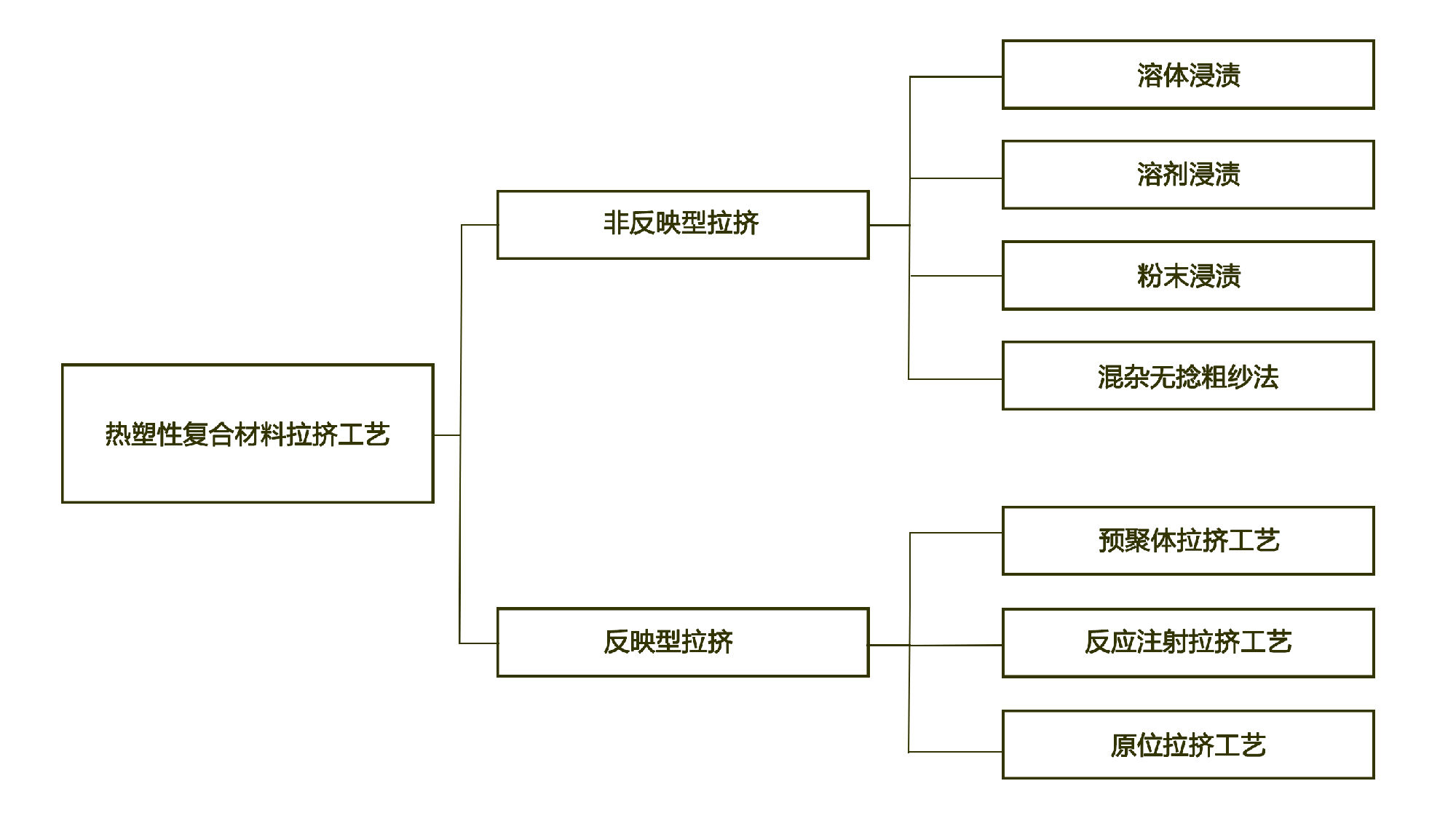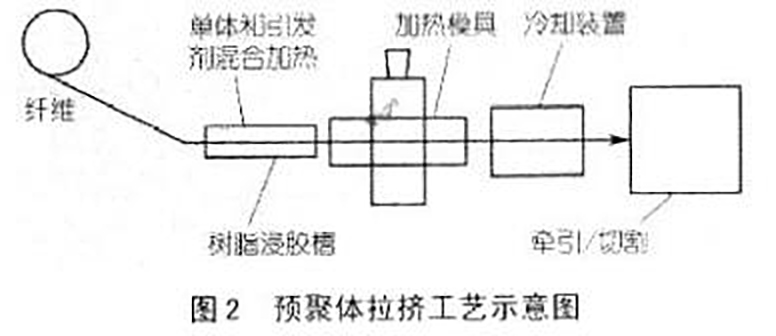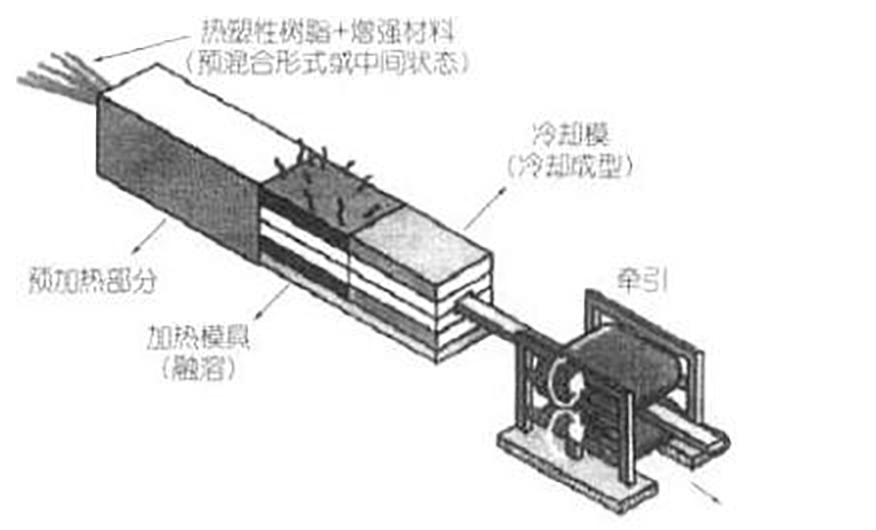The process and characteristics of pultrusion of thermoplastic resin matrix composites
Pultrusion process is mainly used to produce composite products. It is the most widely used technology in composite materials industry. With the environmental problems becoming more and more prominent in recent years,More and more attention has been paid to the fabrication of continuous fiber reinforced thermoplastic composites by pultrusion.
Although thermoplastic pultrusion has a strong flexibility and resistance to strike, good resistance to damage, damage tolerance, high plasticity, and can be welded,Biocompatible, recyclable, molding without curing reaction, rapid molding and repeated use, etc., but has not yet been widely used in commercial applications.The reason lies in the restriction of this process is the following disadvantages such as high melt viscosity, high processing temperature and substrate are solid at room temperature, control cooling and melt cooling shrinkage, fluctuation of product quality etc.
In order to make the pultrusion of thermoplastic materials more widely used, the important task is to develop the most suitable processing technology, reduce costs and improve quality. The pultrusion process itself is a typical manufacturing process of continuous producing composite material, and can realize the automation of continuous production and use of products widely, so the technology industry in developed countries has paid great attention to, the development speed is very fast. Such as American patent (patent number: US5091036) and the publication of Dr.ScottTaylor's research results on thermoplastic composite material, it will bring a breakthrough to the industrial application of pultrusion of thermoplastic composites.
Generally speaking, from thermolset pultrusion into thermoplastic matrix pultrusion encountered key problems include: the matrix are solid at room temperature, poor liquidity in the melting temperature (high viscosity) and melt cooling shrinkage etc. at present, the implementation of thermoplastic resin based composite material the pultrusion of typical research achievements and progress can be summarized as follows.
1、Production process
The thermoplastic resin melt viscosity, impregnation difficulties, key points and improvement research work focused on impregnation technology, and the fundamental difference between different pultrusion is differences in impregnation method and impregnation process on. Generally, according to the impregnation technology, the pultrusion process of thermoplastic composites can be divided into two categories: non reactive pultrusion and reaction pultrusion. From the current application situation, non reactive technology accounted for the main body, the application is more extensive, relatively speaking is also relatively mature.
Sketch of pultrusion process of thermoplastic composites

1.1 Non reaction pultrusion
1.1.1 Melt impregnation
Dipping is a continuous fiber spring that allows for uniform dispersion and pre tension. Through a series of gear trains, the fibers are fully impregnated in the melt resin. In order to improve the permeability, there is usually a certain amount of pressure, or mixed with low molecular weight, the same kind of modified components (or plasticizers) and so on. The process is mature at present. It has the advantages that the fiber is not easy to be winded and can process all the plastic materials which can melt and flow.
1.1.2 Solvent impregnation
This method is the selection of a suitable solvent, can also be mixed with several kinds of solvent solvent, resin will be completely dissolved, prepare solution with low viscosity, and then impregnated fiber, then the recovery of solvent, preparation of prepreg. This method overcomes the disadvantages of thermoplastic resin melting of high viscosity, good impregnation of fibers, the process also exist some problems, such as evaporation and solvent recovery cost is expensive, and is easy to pollute the environment; if the solvent removal is not complete, the formation of bubbles and holes in the composite zhongchanghui.
Therefore, the composite material processed by this method will have some influence on its solvent resistance in use.
1.1.3 Powder impregnation
Powder impregnation preparation technology in fluidized bed, through electrostatic interaction will be adsorbed on the surface of the resin fine fibers, and then heated to melt the powder on the surface of the fiber node, finally in the process of forming the fiber to infiltration. The processing is not limited by the viscosity of the matrix, and the polymers with high molecular weight can be distributed into the fibers. The process has less damage to the fiber and no degradation of the polymer. It has the potential advantages of low cost. The diameter of the resin powder suitable for this technique is 5~10 im.
1.1.4 Mixed roving method
This method is a thermoplastic resin spun fiber or film tape, then reinforced fiber and resin fiber bundle according to the gel content of a certain proportion of the tightly combined into blended yarn, and then through a high temperature sealing impregnation zone, will melt into the matrix resin fiber. The advantage of this method is that the resin content is easy to control, and the fiber can be fully infiltrated.
1.2 Reactive pultrusion
1.2.1 Prepolymer pultrusion process
This resin is used to process the monomer and initiator mixture after heating and melting, the prepolymer initial molecular weight of small, low viscosity and good fluidity, the fiber with side infiltration, side reaction, so as to achieve the ideal effect of impregnation. This process requires rapid polymerization of monomers and precise control of the reaction. The process is suitable for pultrusion of glass fiber, carbon fiber, nylon and other fiber reinforced thermoplastics, and has wide range of applications. The drawing process of the prepolymer is shown in Figure 2

1.2.2 Reaction injection pultrusion
Compared with the usual pultrusion process, reaction injection molding (RIM) pull extrusion technology is characteristic of pultrusion process is the resin component directly into the resin impregnated cavity or pultrusion die entrance and reinforcing material impregnated, and then through the mould heating, it is actually the pultrusion process and molding (RIM) the combined process, a special process and the formation of. In the RIM pultrusion process, the resin system is divided into two components, A and B, each of which does not respond to itself. The resin system A, the B two components after preheating through the metering pump into the resin mixing unit, after mixing directly into the mold cavity or impregnated with resin impregnated entrance enhancing material, the reinforcing material after preheating, thus ensuring the resin impregnated in high temperature conditions, when the viscosity of the resin system is very low. So the fiber permeability excellent; mixing and use of resin components at the same time, there is no use of the resin, the resin mixing unit adjacent to the entrance of the die, so it is possible to use fast curing resin system or a solid at room temperature.
The RIM pultrusion process is shown in Figure 3:

1.2.3 In-situ pultrusion
This pultrusion process is similar to the RIM process. The difference is that the resin on line is directly injected into the pultrusion die.
2、Production equipment
In comparison with thermoset pultrusion equipment, thermoplastic resin pultrusion requires the addition of specific equipment, such as impregnating stations (powder or melt troughs), special molds and cooling segments. In the process of powder impregnation and melt extrusion of thermoplastic resin, reactive pultrusion and non reactive pultrusion, the reinforcing fiber needs to be preheated (as shown in Figure 4). Foreign Unversity of Ghent, Department of textiles has designed and developed a set of fiber reinforced plastics for thermoplastic pultrusion molding production line, the pre heating device added can effectively improve the dispersion performance of reinforced fiber and resin, and the melt viscosity, fiber reinforced material quantity, initial temperature and traction force etc. the parameter is the determinant factor of length and temperature of pre heating device.

2.1 Comparison of pultrusion equipment for thermoplastics and thermoset plastics
(1)In the material aspect, the thermosetting material is extruded and reinforced: the reinforcing fiber and resin are evenly mixed in the pultrusion process through the dipping tank; the thermoplastic is extruded; the fiber and resin are extruded directly by pre impregnated fibers.
(2)In the mold aspect, the thermosetting plastic pulls the extrusion: in the mold, by heating the thermosetting thermoplastic extrusion, in the mold by cooling solidification, and in the mold has the heating device. Ensure that the fiber and resin are dispersed evenly.
2.2 The characteristics of thermoplastic pultrusion die
The thermoplastic pultrusion die is the core part of the whole production line. Product hardening, forming and cooling process in the mould by the pressure and temperature transfer, the basic requirements of thermoplastic pultrusion mould of the general requirements on thermosetting plastic pultrusion die, such as good wear resistance, high surface smoothness, cavity size stability, easy operation and partition temperature control. These objectives can now be achieved by using chromium plated tools, steel, double deck designs, and electrical heating elements.
Usually require the mould cavity should be polished and hard chrome plated die hardness standard HRC70, roughness of Rz< 0.4. The length of the hardened zone depends on the heat compensation process or the required hardening time. According to the literature reports, the hardened zone can range from 50 to 500 to 1000mm.
It has been proved that the die shape from 300 to 500mm can give the best shape and mechanical properties of pultruded profiles.
Generally, the thermoplastic pultrusion dies should be separated into different temperature zones (shown in Figure 5), which are mainly divided into two parts: heating and cooling. The heating part is in order to ensure the uniform distribution of fibers and resin, long heating can guarantee enough pressure to make the resin / glass full flow mixing, and cooling part is mixed in order to ensure the dimensional stability. The thermal isolation ensures a suitable temperature gradient in the length direction of the die, and uses a mandrel with different diameters to accommodate different shrinkage characteristics of different melts.

Thermoplastic resin matrix pultrusion in foreign countries has entered a practical stage, it is still at the preliminary stage to explore the application of our country, to accelerate the development and application of this molding technology, Guan Jian is the right choice to fully grasp the impregnation and process parameters of enhancement of the fiber, and can improve the stability of production equipment.


